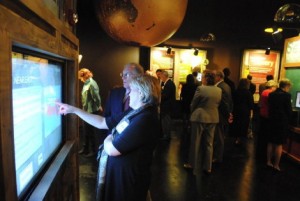Electronic Art’s Interactivity At Slavery Exhibition
Gail Chiasson, North American Editor
Electronic Art, Cincinnati, contributed to Invisible: Slavery Today, a new exhibit at the National Underground Railroad Freedom Center, by creating and installing the digital interactive displays and many of the video components of the exhibit.
 The exhibit includes 17 HD touch-screen displays and several digital kiosks, including a 55” touch screen display that allows visitors to access statistics on modern slavery from the U.S. State Department.
The exhibit includes 17 HD touch-screen displays and several digital kiosks, including a 55” touch screen display that allows visitors to access statistics on modern slavery from the U.S. State Department.
“Museum exhibits are starting to move towards more interactive, digital content,” says Tim Burke, Electronic Art president. “Museum goers have come to expect leading-edge technology as well as some element of interaction to be a part of the overall experience. We’re honored that we could contribute to Invisible: Slavery Today and use technology to bring awareness to this issue and help it resonate with people. This exhibit was created in a very short time frame, yet we were able to deliver quality design and programming for the exhibit opening.”
Paul Bernish, director of Anti-Slavery and Human Trafficking Initiatives at the Freedom Center, says, “Electronic Art was a tremendous partner in putting this exhibit together, We’ve had a longstanding collaboration with the company for our website design. Its work on this exhibit is a tribute to Electronic Art’s versatility. I would recommend it without hesitation.”
 Invisible: Slavery Today is a museum-quality, permanent exhibition on the subjects of modern-day slavery and human trafficking that occupies some 4,000 sq. ft. in the Freedom Center’s east pavilion. Through a variety of techniques and media, including videos, sounds, and touch-screen presentations, Invisible offers a comprehensive examination of slavery in the modern world through the life experiences of five individuals who were caught up in one of the five most common forms of exploitation.
Invisible: Slavery Today is a museum-quality, permanent exhibition on the subjects of modern-day slavery and human trafficking that occupies some 4,000 sq. ft. in the Freedom Center’s east pavilion. Through a variety of techniques and media, including videos, sounds, and touch-screen presentations, Invisible offers a comprehensive examination of slavery in the modern world through the life experiences of five individuals who were caught up in one of the five most common forms of exploitation.
The concluding section of the exhibition is devoted to anti-slavery activities underway around the world, including efforts from the Freedom Center’s partners in the exhibition: Free the Slaves, Goodweave, International Justice Mission, and Polaris Project. Visitors are also asked to make a personal commitment to be 21st Century Abolitionists in the cause of freedom by adding their commitment to touch screen kiosks, which are digitally integrated into large format content.
The exhibition will be a permanent addition to the museum

Follow DailyDOOH